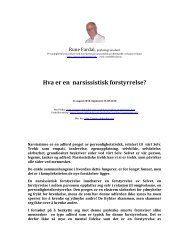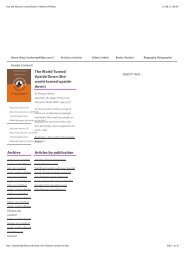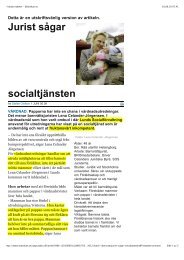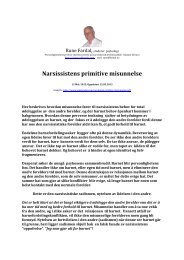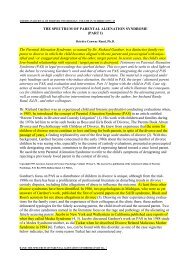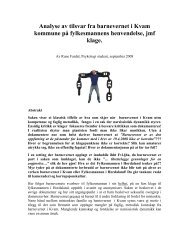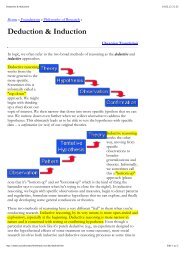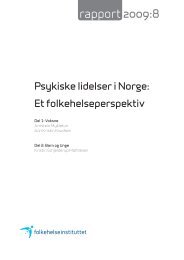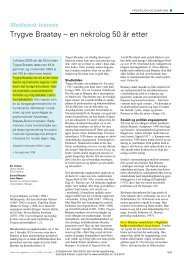The origins of narcissism and narcissistic personality disorder a
The origins of narcissism and narcissistic personality disorder a
The origins of narcissism and narcissistic personality disorder a
You also want an ePaper? Increase the reach of your titles
YUMPU automatically turns print PDFs into web optimized ePapers that Google loves.
76 JOHN S. AUERBACH<br />
others is represented (Auerbach, 1990). In this regard, egocentrism,<br />
defined as the inability to shift from one’s own perspective to the<br />
viewpoint <strong>of</strong> the other <strong>and</strong> thus to regard oneself as an object (Piaget,<br />
1923/1951, 1924/1952, 1926/1960), clearly involves a disturbance in<br />
the representation <strong>of</strong> self, especially when this cognitive limitation is<br />
manifested in a manner inappropriate for a person’s age or presumed<br />
level <strong>of</strong> cognitive organization. It is therefore noteworthy that the two<br />
most prominent theories <strong>of</strong> <strong>narcissism</strong>, those <strong>of</strong> Kohut (1977, 1984)<br />
<strong>and</strong> Kernberg (1975, 1984), despite their many differences, regard <strong>narcissistic</strong><br />
<strong>personality</strong> <strong>disorder</strong>s as involving disturbances in the representation<br />
<strong>of</strong> self <strong>and</strong> others, not just disruptions <strong>of</strong> self-esteem regulation.<br />
Kernberg argues that <strong>narcissistic</strong> <strong>personality</strong> <strong>disorder</strong> involves<br />
a pathological fusion <strong>of</strong> real self, ideal self, <strong>and</strong> ideal object. Not a<br />
misallocation <strong>of</strong> libido, but a pathological self-formation, with its concomitant<br />
distortions <strong>of</strong> object representation, is the essential feature <strong>of</strong><br />
Kernberg’s underst<strong>and</strong>ing <strong>of</strong> <strong>narcissistic</strong> disturbance. As for Kohut, his<br />
emphases on selfobjects <strong>and</strong> self-experience indicate that the fundamental<br />
problem in pathological <strong>narcissism</strong> is the manner in which one<br />
experiences oneself <strong>and</strong> one’s ties to sustaining figures <strong>and</strong> that disturbances<br />
in self-esteem follow from disruptions <strong>of</strong> the matrix <strong>of</strong> selfobject<br />
ties. But if distortions <strong>of</strong> self- (<strong>and</strong> object) representation are the<br />
essential feature <strong>of</strong> <strong>narcissistic</strong> <strong>personality</strong> <strong>disorder</strong>, the specific nature<br />
<strong>of</strong> those distortions also must be delineated.<br />
Self-Reflexivity<br />
Returning, then, from the realm <strong>of</strong> pathology to that <strong>of</strong> normality, let<br />
us consider that the self-representation is unique among the constituents<br />
<strong>of</strong> the representational world. What distinguishes the self-representation<br />
from representations <strong>of</strong> objects is self-reflexivity (Mann,<br />
1991; Mead, 1934). In his classical account <strong>of</strong> the self, James (1890/<br />
1958; cf. Mead, 1934; Schafer, 1968) distinguished between the I (the<br />
self as knower or agent, as subject) <strong>and</strong> the me (the self as known, as<br />
object). Whereas one knows, <strong>and</strong> relates to, objects only through what<br />
one can observe <strong>and</strong> infer about them, the situation with self is far<br />
different. Self-knowledge, in contrast to knowledge <strong>of</strong> others, involves<br />
(at least) two sources (Bach, 1985; Duval & Wicklund, 1972; M. Lewis<br />
& Brooks-Gunn, 1979; Mead, 1934; Piaget, 1924/1952, 1926/1960,<br />
1937/1954): (a) subjective self-awareness, or the experience <strong>of</strong> oneself




